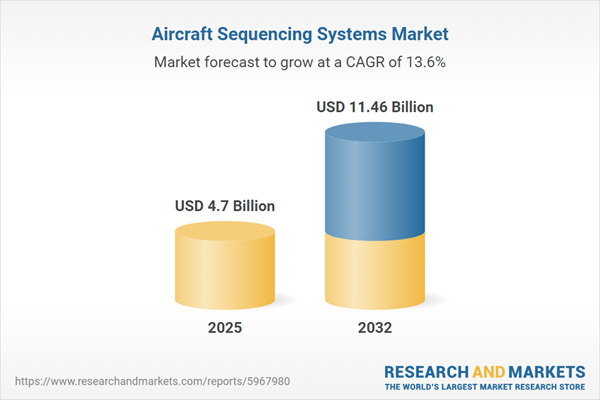Speak directly to the analyst to clarify any post sales queries you may have.
The Aircraft Sequencing Systems Market is evolving rapidly as air traffic stakeholders intensify their focus on operational efficiency, safety, and resilience. Senior decision-makers across aviation increasingly recognize the urgency to modernize sequencing systems to maintain competitiveness and meet rising demands for punctuality and sustainability.
Market Snapshot: Aircraft Sequencing Systems Market
The Aircraft Sequencing Systems Market grew from USD 4.12 billion in 2024 to USD 4.70 billion in 2025. Continued expansion at a CAGR of 13.62% is projected, taking the market to USD 11.46 billion by 2032. These figures illustrate significant momentum, driven by the integration of advanced technologies across air traffic management, airlines, and airport ecosystems.
Scope & Segmentation
- System Types: Hardware (including ground and onboard equipment), Services (consulting, installation, maintenance & support), Software (conflict detection, sequencing optimization, trajectory prediction).
- Technology: ADS-B (ADS-B In, ADS-B Out), Radar (primary, secondary), Satellite-based (geo and low-earth orbit satellites).
- Application Areas: Arrival management (final sequence, metering), Departure management (pre-departure sequence, pushback coordination), Surface management (gate sequencing, taxi sequencing).
- End Users: Air navigation service providers (federal and private), Airlines (cargo, commercial, low cost), Airports (international, regional).
- Deployment Modes: Cloud-based (private and public cloud), Hybrid (edge deployment, mixed deployment), On-premise solutions.
- Regional Coverage: Americas (North America: United States, Canada, Mexico; Latin America: Brazil, Argentina, Chile, Colombia, Peru); Europe, Middle East & Africa (Europe: United Kingdom, Germany, France, Russia, Italy, Spain, Netherlands, Sweden, Poland, Switzerland; Middle East: United Arab Emirates, Saudi Arabia, Qatar, Turkey, Israel; Africa: South Africa, Nigeria, Egypt, Kenya); Asia-Pacific (China, India, Japan, Australia, South Korea, Indonesia, Thailand, Malaysia, Singapore, Taiwan).
- Key Vendors: Thales S.A., Leonardo S.p.A., Honeywell International Inc., Raytheon Technologies Corporation, Collins Aerospace Inc., Frequentis AG, Indra Sistemas S.A., L3Harris Technologies Inc., Saab AB, Lockheed Martin Corporation.
Key Takeaways for Senior Decision-Makers
- The adoption of artificial intelligence, satellite surveillance, and cloud-edge orchestration is transforming sequencing paradigms and enhancing operational collaboration among aviation stakeholders.
- Effective sequencing systems require strong data interoperability, human-machine collaboration, and a focus on secure, standards-based integrations to support sustainable and seamless operations.
- Procurement decisions are increasingly shaped by modular software and service models that offer incremental modernization without disrupting certified baselines or existing investments.
- Differentiated regional adoption patterns are emerging based on regulatory frameworks, infrastructure maturity, and local workforce capabilities, requiring tailored strategies for successful deployment.
- Vendor partnerships and certification readiness are critical for reducing time-to-deployment and minimizing risks associated with legacy system transitions.
- Operational success depends on shared governance models, measurable KPIs, and investment in workforce transition programs to realize the benefits of hybrid automation in sequencing functions.
Tariff Impact: Navigating Supply Chain and Modernization Risks
Recent United States tariff measures have introduced new complexities for procurement and supply chains within aircraft sequencing programs. Higher input costs and longer lead times are prompting both vendors and buyers to localize manufacturing, redesign hardware with increased emphasis on software-defined capabilities, and establish contingency-focused procurement strategies. This environment is accelerating modular delivery models and heightening scrutiny of total cost of ownership across industry stakeholders.
Methodology & Data Sources
The insights presented draw on structured interviews with operational leaders, technical briefings with vendors, and analysis of public policy documents and technical standards. Evaluation of pilot programs and stress-testing of deployment scenarios provided a realistic perspective on supply chain, regulatory, and operational contingencies influencing system adoption.
Why This Report Matters
- Offers actionable intelligence to support technology, procurement, and partnership choices amid rapidly evolving regulatory and operational requirements.
- Identifies region-specific adoption drivers, enabling tailored investment and deployment strategies that reduce implementation risk.
- Guides the alignment of internal teams and partners around modernization pathways that balance urgency with operational resilience and regulatory compliance.
Conclusion
Modernizing aircraft sequencing systems demands strategic integration of emerging technologies, robust supply chains, and collaborative governance. Organizations that focus on flexible architectures, stakeholder coordination, and regulatory alignment will achieve faster, safer, and more cost-effective transformation.
Additional Product Information:
- Purchase of this report includes 1 year online access with quarterly updates.
- This report can be updated on request. Please contact our Customer Experience team using the Ask a Question widget on our website.
Table of Contents
3. Executive Summary
4. Market Overview
7. Cumulative Impact of Artificial Intelligence 2025
Companies Mentioned
The companies profiled in this Aircraft Sequencing Systems market report include:- Thales S.A.
- Leonardo S.p.A.
- Honeywell International Inc.
- Raytheon Technologies Corporation
- Collins Aerospace Inc.
- Frequentis AG
- Indra Sistemas, S.A.
- L3Harris Technologies, Inc.
- Saab AB
- Lockheed Martin Corporation
Table Information
| Report Attribute | Details |
|---|---|
| No. of Pages | 182 |
| Published | October 2025 |
| Forecast Period | 2025 - 2032 |
| Estimated Market Value ( USD | $ 4.7 Billion |
| Forecasted Market Value ( USD | $ 11.46 Billion |
| Compound Annual Growth Rate | 13.6% |
| Regions Covered | Global |
| No. of Companies Mentioned | 11 |









